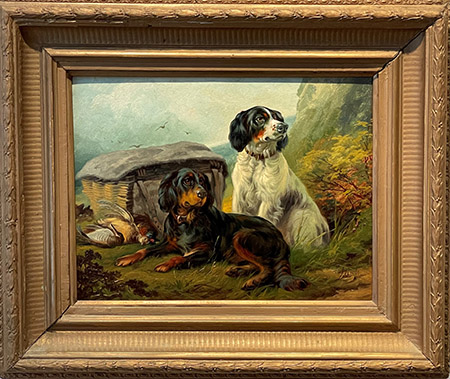
English Setter
|
|
The Setter family is composed of English, Irish and Gordon Setters, and although their exact origins are uncertain, they undoubtedly derived from the same parent stock. Early sporting writers describe them as "setting" or "crouching" Spaniels, in contrast with the "finding" or springing" Spaniel, who flushed game without pointing it. As time went on, the setting variety was evidently bred larger and larger, with a view to increasing its speed. Most writers agree that as early as 1555, Robert Dudley, Duke of Northumberland, trained setters to work with a net. Although the three Setter breeds are quite dissimilar, they all have common ancestors. On one side is the Spaniel, while the other is a matter of conjecture. Most think that the old Spanish Pointer was its other ancestor, providing strong scenting power and staunchness in the field. Much of the credit for the development of the English Setter as a distinct breed goes to Edward Laverack, who from about 1825 produced top English Setters. Another noted English Setter breeder was R. L. Purcell Llewellin. At about the time that the Laverack strain was at its zenith in England, Llewellin purchased a number of Laverack's best show dogs, and crossed them with a strain from another part of England. The resultant dogs became well known, particularly at field trials, and the strain became known as the Llewellin Setter. Today, we simply refer to the breed as the English Setter, although most English Setter fanciers trace their dogs back to one or the other of the above types. |
Home | About
the WS Gallery | Current
Exhibition | New
Additions | Search Our Inventory
| Commissioning Paintings | 19th
& 20th Century Oils | Contemporary
Artists | Works
on Paper & Collectibles | Books
| Christine Merrill
| Guest book | Email
Us
All images, designs and information on this site
are fully copyrighted © 1999
and may not be reproduced of used in any form or any manner, or displayed in
any way
on any website without the express written consent of The William Secord Gallery,
Inc.
William Secord Gallery, Inc.
29 West 15th Street 4th floor
New York, NY 10011
Between Fifth and Six Avenues
www.dogpainting.com
wsecord@dogpainting.com
Tel. 212-249-0075
212-249-0896
By appointment
